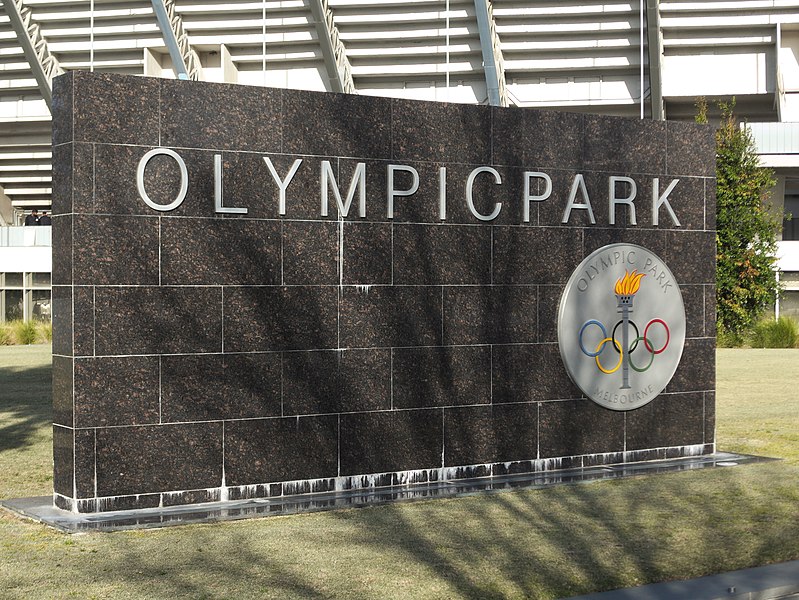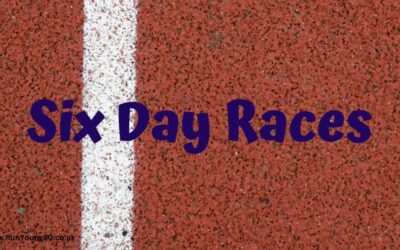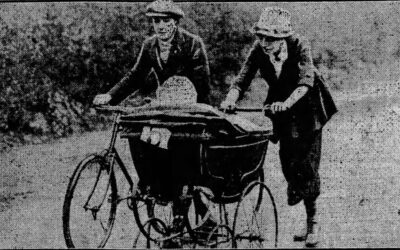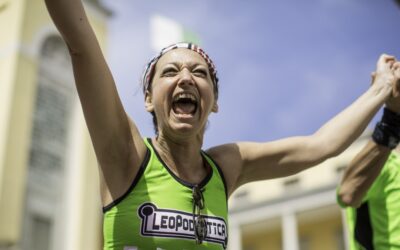It isn’t too often that everything goes well and perhaps this is part of the attraction of the 24 hour race – the waiting for the perfect day and the perfect performance.
Eleanor Adams
The period from 1985 to 1990 saw top performances from Eleanor Adams (now Robinson) in 24-hour races. Adams set world bests at five out of the eight 24-hour races she competed in. And the 24-hour track race at Melbourne’s Olympic Park in August 1989 marked a peak. Despite adverse weather conditions, this was a perfect performance. Adams set world records for 24 hours and 200kms, becoming the first woman to run over 240km in a 24-hour race.
When Adams was inducted into the IAU Hall of Fame in 2001, she was asked to choose her top ten performances. This race was the eighth in her list.
The race was held at the now-demolished Olympic Park Stadium. The stadium was built a warm-up athletics track and soccer venue for the 1956 Olympic Games.
Writing in the Road Runners Club newsletter in April 1990, Adams related that the race organisers had hoped to put on a top class women’s race and invited the four women who had already run over 140 miles, as well as New Zealanders Sandra Barwick and Sue Andrews. Adams had run 142.9 miles (229.991km) at the Milton Keynes 24h indoor race at the Westfield shopping centre in February 1989. The other three women were:
- Angela Mertens of Belgium who had run 144.2 miles (232.107km) at the 24 uren van Heusten road race in Belgium in October 1988
- Marianne Savage of Great Britain who had run 142.9 miles (230.013km) at the North Solihull 24 Hour track race in July 1988
- Hilary Walker of Great Britain who had run 146.9 miles (236.453km) at the Preston 24h road race in August 1988
Despite the organisers’ hopes, they were unable to give much notice of the race and Adams was the only one of the six women to accept. The other three women in the race were Australians.
Adams was keen to compete. Despite not liking the heat, she loved running in Australia. By August 1989, she had already competed four times in the Colac 6 Day race and three times in the Westfield Sydney to Melbourne run, finishing first woman on every occasion. Later that year, she would finish first at Colac again.
I knew that I was in good shape and I went out hoping to attack both the world best 24 hour distance and the GB 100km record.
The men’s field was strong and, as was common in some of the Australian ultradistance events, there was just one prize list; the women competing as equals with the men. Whilst my aim was for the records, I also wanted to place as high as possible and it was this desire that drove me to achieve my best ever 24-hour performance. I was also running for the first time in a GB vest which provided the extra motivation to do well.
Another motivation was to regain the 24-hour track record. Adams had set the record in a track race at Nottingham in August 1985. She ran 222.8km, finishing first out of six runners. Angela Mertens had bettered this at a race in Belgium in July 1988, running 226.237km (over 140 miles).
The build-up to the race
Adams described the days before the race in an article in the Road Runners Club newsletter. Adams was a teacher with school-age children. As the race fell during the school holidays, she was able to arrive in Australia a week before the race.
My sponsors, Pozzani Water Purifiers, arranged for me to take part in the annual City of Sydney to Surf race on 13th August. This event is an enormous 14km Fun Run of 45,000 competitors, including several of the world’s top runners.
I was terrified to find that I had been allocated a position in the very front alongside Steve Moneghetti etc. However, I was very pleased with my fourth position in the ladies race and first veteran lady.
Adams had time to visit the Rotaract 1000 Mile Track Challenge Race being held in Granville near Sydney and support her friends Pat Farmer, Tony Rafferty and Dave Taylor who were attempting to beat the world record. The race had started on 12th August.
Adams and the other top competitors were kept busy in the week before the race with daily TV and radio interviews.
Race day – the HI-TEC International Melbourne 24h
The race took place over the weekend of 19th/20th August, starting at 11.30am on the Saturday. It was sponsored by HI-TEC, manufacturers of running shoes.
Adams and Patrick Macke represented Great Britain. There were two runners from New Zealand and the remainder were Australians, including Bryan Smith who held the Australian 48-hour and 6-day records. 24 runners completed the race.
On the morning of the race the spring weather changed from sunny to cold and windy. The cooler temperatures suited Adams better.
Many of the Australian competitors wore track suits, woolly hats and gloves. I found I was comfortable enough in a T-shirt over which I proudly wore my GB vest.
Adams relates that the initial pace was very quick, but by the 100km mark some of the early leaders had dropped away and a group of five runners had broken clear of the rest of the field. David Standeven, winner of that year’s Sydney to Melbourne race, was in the lead, followed by Adams, Smith, Macke and John Breit.
It was at this point, about 9 hours into the race, that the weather changed.
By now the very strong wind had eased, but in its place came rain. The heavens opened and it came down in sheets. Wet weather wear was hastily donned. The rain bounced up from the all-weather surface which quickly became flooded. It poured solidly for three hours. The track never drained, and for a while we were splashing through a river 3-4 inches deep. Even when the rain did stop, the track never cleared, and we ran through puddles right to the end of the race.
Adams reached 100 miles in 14 hours 44 minutes and 25 seconds, taking almost 45 minutes off her personal best. By then Bryan Smith had moved into second place and Adams was third.
Adams achieved a 200km world record of 19 hours 28 minutes and 48 seconds. Smith had overtaken Standeven and Adams was quickly catching him. Adams passed the 24-hour track record with nearly 90 minutes still to go and caught up with Standeven.
We were level with an hour to go, and in that last hour I was running for second place in the race, as well as to see what distance I could achieve. The last two laps were a mad “sprint” as I pushed for the 240km mark.
The crowd of supporters, handlers, officials, lap scorers, all gave me tremendous encouragement and the sense of achievement as I passed 240km (149.1 miles) was enormous.
The top five runners were:
- Bryan Smith (AUS) 254.515km
- Eleanor Adams (UK) 240.169
- David Standeven (AUS) 238.407
- John Breit (AUS) 227.557
- Patrick Macke (UK) 224.450
The three other women in the race all covered more than 100 miles:
11. Dawn Parris (AUS) 203.650
12. Georgina McConnell (AUS) 195.355
16. Trisha Spain (AUS) 162.913
On completing the race, Adams was taken straight to the media area for a TV interview. “They took great interest in the appalling state of my feet. Removing my shoes and socks was probably the most painful part of the whole event!” She had been running for 17 hours in soaking wet shoes and socks.
In his ultramarathon review of the year, Andy Milroy noted that in the Melbourne 24-hour race Adams became the first woman to average 10km an hour for a whole day.
Adams rated this race as a perfect performance as she felt good throughout and didn’t have any problems. She even felt that she could have run further…
Had it not been for battling into the wind then I firmly believe that I would have run 150 miles that day.
…………………………………………….
Notes
Read about Eleanor Adams’ other top ten performances:
1984 New York 6 Day Race
1984 Colac 6 Day Race
1986 Westfield Sydney to Melbourne Race
1987 The first Badwater Race
1990 IAU International 24 Hour Championships Milton Keynes
1990 & 1991 IAU 100km World Championships
1994 Telecom Tasmania Run
1998 Nanango 1000 Mile Track Race
and another race that did not make it into the top ten:
1983 The first Spartathlon
Eleanor Adams’ 24-hour track world record stood until at least 1996. According to UK Athletics, Adams still holds the GB 12 hour all surfaces record and 24 hour track record set in this race (records last updated 31st December 2018). Her time of 14:44:25 stood as the GB 100 mile track record for 32 years until it was broken on 24th April 2021 by Samantha Amend who ran 14:34:03 at the Centurion Running 100 Mile Track race in Ashford, Kent (record subject to ratification).
The current 24-hour world best performance (as of 2nd march 2022) is held by Camille Herron of the USA, who ran 270.116km at the IAU 24h World Championships in Albi, France in October 2019.
The Rotaract 1000 Mile Track Challenge Race was held at the Granville athletics track in Everley Park, Granville near Sydney. Pat Farmer had challenged Tony Rafferty to the race. To meet the criteria for an official race there had to be at least three competitors. Dave Taylor agreed to be the third runner. They were attempting to beat the world record held by Great Britain’s Malcolm Campbell. The race had started on 12th August. Tony Rafferty broke the world record by 33 hours, finishing in 14 days 11 hours 59 minutes and 4 seconds. Pat Farmer also broke the record, taking about 6 and a half hours longer than Rafferty. Taylor withdrew at 795 miles with a broken toe.
Dawn Parris set Australian records for 12 hours, 24 hours, 100 miles and 100km in the race. Her 24 hour time is still good enough for 12th place on the Australian all-time list. In October 1990, she competed against Adams again in the IAU 100km World Championships in Duluth, USA.
Sources:
Interviews with Eleanor Robinson, June 2018 and May 2019
Articles
“How Far Can Woman and Man Run in the Cycle of the Sun? by Eleanor Adams, Road Runners Club newsletter, April 1990
“Ultramarathon Review 1989” by Andy Milroy, Road Runners Club newsletter, April 1990
“My Top Ten Performances” by Eleanor Robinson, IAU Newsletter, March 2001
Articles on the 1000 Mile Track Challenge and the Melbourne 24h track race, AURA (Australian Ultra Runners Association) newsletter, December 1989
Results and records
Ultra Marathon Statistics, Deutsche Ultramarathon Vereinigung website
Note of Angela Mertens’ world best track performance, Road Runners Club newsletter, August 1989
UKA website, GB ultra-running records
Records table, updated 01/01/2022, IAU Records Committee 2021-2025, IAU website
Australian all-time rankings, AURA website
With thanks to Eleanor Robinson for lending me copies of the Road Runners Club and IAU Newsletters.
Thank you to Andy Milroy for informing me of Marianne Savage’s race performance.
Banner photo: Olympic Park sign now situated on Olympic Boulevard in Melbourne taken by Gary Houston, Wikimedia Commons, made available under the Creative Commons CC0 1.0 Universal Public Domain Dedication.




0 Comments